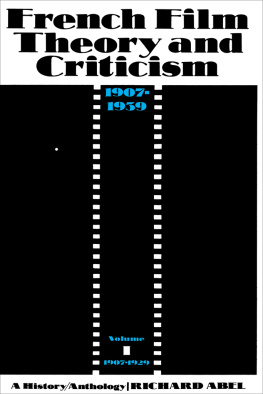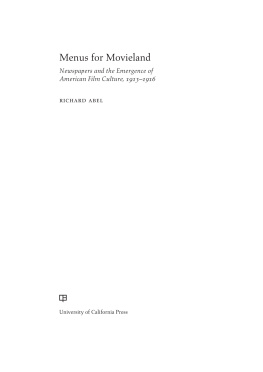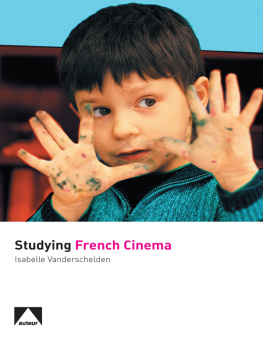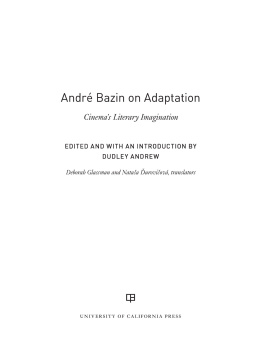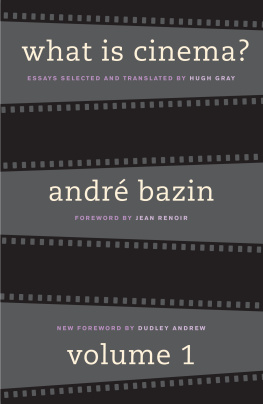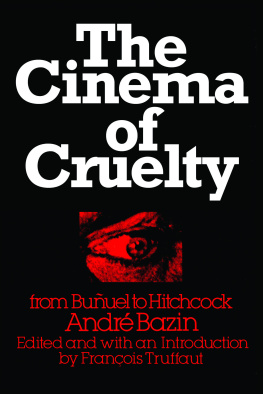French Film Theory and Criticism
VOLUME I: 1907-1929
FRENCH FILM
THEORY AND
CRITICISM
A HISTORY/ANTHOLOGY
1907-1939 & RichardAbel
Volume 1: 1907-1929
PRINCETON UNIVERSITY PRESS / PRINCETON, NEW JERSEY
COPYRIGHT 1988 BY PRINCETON UNIVERSITY PRESS
Published by Princeton University Press, 41 William Street,
Princeton, New Jersey 08540
In the United Kingdom: Princeton University Press, Chichester, West Sussex
All Rights Reserved
Library of Congress Cataloging-in-Publication Data will be found on the last printed page of this book
ISBN 0691055173 (v. 1: alk. paper)
ISBN 069100062X (v. 1: pbk.)
eISBN: 978-1-400-83548-5
R0
A Barbara, encore une fois
What was a Heffalump like?
Was it Fierce?
Did it come when you whistled? And how did it come?
Was it Fond of Pigs at all?
If it was Fond of Pigs, did it make any difference what sort of Pig?
Supposing it was Fierce with Pigs, would it make any difference if the Pig had a grandfather called TRESPASSERS WILLIAM?
Piglet didnt know the answer to any of these questions... and he was going to see his first Heffalump in about an hour from now!
Of course Pooh would be with him, and it was much more Friendly with two. But suppose Heffalumps were Very Fierce with Pigs and Bears?
A. A. Milne, Winnie-the-Pooh, 1926
Contents
x
xiii
xxiii
3
33
35
47
50
53
54
55
58
66
67
77
86
89
90
95
125
125
128
131
132
136
137
140
142
143
155
159
165
168
171
172
174
182
183
183
188
193
224
224
223
228
229
235
241
246
249
233
238
268
271
271
274
279
280
283
283
291
303
305
314
321
349
349
333
362
364
368
370
371
372
373
384
383
389
398
400
401
403
408
410
412
414
417
420
421
422
423
429
432
437
Note on Notes
NOTES to the preface and the critical essays introducing each of the four parts of this book appear immediately following the preface and each essay. Notes to the anthology selections immediately follow each selection. The anthology notes are mine unless otherwise indicated: those written by the author of the selection are marked Au; those by the translator, if other than myself, are marked TRANS.
Explanations, analyses, interpretations, are no more than frames or lenses to help the spectator focus his attention more sharply on the work. The only justification for criticism is that it allows us to see more clearly.
John Berger, About Looking (1980)
[History] has taken as its primary task, not the interpretation of the document, not the attempt to decide whether it is telling the truth or what is its expressive value, but to work on it from within and to develop it: history now organizes the document, divides it up, distributes it, orders it, arranges it in levels, establishes series, distinguishes between what is relevant and what is not, discovers elements, defines unities, describes relations. The document, then, is no longer for history an inert material through which it tries to reconstitute what men have done or said, the event of which only the trace remains; history is now trying to define within the documentary material itself unities, totalities, series, relations.... history is one way in which a society recognizes and develops a mass of documentation with which it is inextricably linked.
Michel Foucault, The Archaeology of Knowledge (1969)
As for me, I wanted to see the film as close up as possible. I had learned in the equalitarian discomfort of the neighborhood [cinemas] that this new art was mine, just as it was everyone elses. We had the same mental age: I was seven and knew how to read; it was twelve and did not know how to talk. People said that it was in its early stages, that it had progress to make; I thought that we would grow up together. I have not forgotten our common childhood: whenever I am offered a hard candy, whenever a woman varnishes her nails near me, whenever I inhale a certain smell of disinfectant in the toilet of a provincial hotel, whenever I see the violet bulb on the ceiling of a night train, my eyes, nostrils, and tongue recapture the lights and odors of those bygone halls; four years ago, in rough weather off the coast of Fingals Cave, I heard a piano in the wind.
Jean-Paul Sartre, The Words (1964)
Preface
S OME YEARS AGO, in a whimsical mood, Bertrand Tavernier warned that anyone displaying the least interest in the French cinema, especially prior to the forties, would be seen as an amnesic dinosaur, a collector of irrelevant relics, and would be in grave danger of imminent departure for a mental institution. Such authoritative assertions, although once accepted as valid, are now open to question, particularly in the light of recent historical scholarship.
A growing number of essays and books have drawn attention to the wide range and rich perspicacity of early French writing on the cinema as well as to its supposed faults and lacks. Stuart Liebman, for instance, has suggested that the film theories developed in France between 1910 and 1921 may ... be regarded as seminal contributions to the discipline of film theory. What is needed now is a historical study that, building on this scholarship, can take as its subject the sheer plenitude of early French writing on the cinemawith all of its contradictionsas well as the unusually sustained continuity of its development as a discourse over several decades.
Such a studyand the further debate it should produceis circumscribed, however, by the limited availability of primary texts. In scattered books and journals, to be sure, recent translations of some major figures have appearedfor example, Abel Gance, Jean Epstein, Germaine Dulac, Ren Clair, Antonin Artaud, Ricciotto Canudo, Andr Antoine, Georges Mlis. Demonstrating the value and usefulness of early French writing on the cinema, therefore, must coincide with an effort to recover as much of that writing as possible.
This bookand its companion volume, French Film Theory and Criticism, 19291939to appropriate the language of Michel Foucault, is conceived, then, as an archaeological project.map or historical framework for early French film theory and criticism as well as a site or archive for others subsequently to engage with, reimagine, and rewrite.

